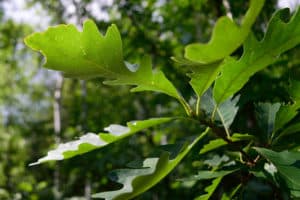 When selecting trees for landscaping, many will choose the more popular varieties – dogwood, tulip trees, arborvitae, and others. It makes sense, people see these trees in landscaping and like the look of them, so they choose it too. One that is often overlooked is the swamp white oak.
When selecting trees for landscaping, many will choose the more popular varieties – dogwood, tulip trees, arborvitae, and others. It makes sense, people see these trees in landscaping and like the look of them, so they choose it too. One that is often overlooked is the swamp white oak.
The swamp white oak (Quercus bicolor) has one great distinction in America: it is featured at the 911 Memorial in New York. They provide a stark and welcome contrast to the two wells of constantly cascading water that mark the footprint of the Twin Towers. One of the deciding factors in choosing this species is that they are native to all three locations where the planes crashed that fateful day – New York City, Arlington County in Virginia, and Shanksville, Pennsylvania. (Interesting note: the one tree at the memorial that is not a swamp white oak is the “survivor” tree, a callery pear tree that survived the attacks and was re-planted at the memorial. A true survivor!)
These trees adapt well to the challenges of an urban environment, tolerating dry, moist, or wet soils as well as salt and soil compaction. This adaptability makes them a great choice for almost any landscape.
Swamp White Oak Quercus bicolor
 Used as large shade trees in landscaping
Used as large shade trees in landscaping- Wood has been used in ship building throughout American history, but is used today in flooring, furniture, and whiskey/wine barrels.
- Mature trees generally reach 80-100 feet, while some have reached 150. Trunk size can reach up to 4’ in diameter!
- Acorns produced by white oaks are an important source of food for the ecosystem of the tree. All sorts of birds (including turkeys, quails, blue jays, and crows) and mammals (black bear, deer, squirrels, voles, mice) depend on them for nutrients in the fall. In some areas, the population of some species of critters fluctuate based on the supply of acorns!
- In the summer, leaves are a blue-green on top and a whitish shade of green on the underside. In the fall, the colors can spread from orange, and brown to red and purple.
- State tree of Illinois, Connecticut, and Maryland.
- Very adaptable, tolerating dry, moist or wet soils.
